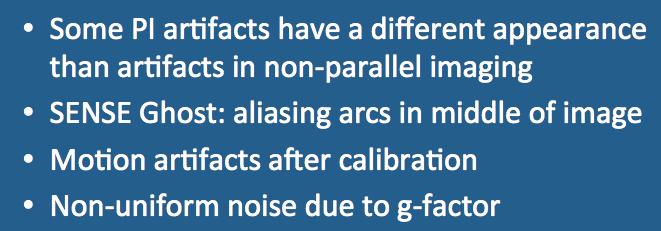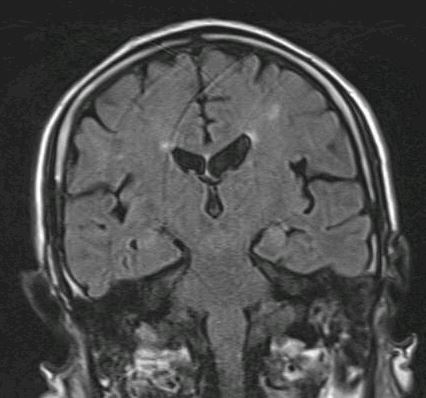Parallel imaging (PI) is beset by the same types of artifacts that affect "regular" MR imaging: noise, motion, aliasing, chemical shift, Gibbs, susceptibility, RF-interference, etc. However, these artifacts may have slightly different appearances because they are acted upon by the complex PI reconstruction process, including generation of coil sensitivity maps, thresholding/masking, polynomial fitting, and estimation of spatial harmonics or weighting factors for image unfolding.
|
Aliasing is a well-recognized cause of artifact in all types of MR imaging. Aliasing occurs whenever a signal is sampled at a rate that is not at least 2x greater than the band of frequencies contained within that signal. The usual type of aliasing artifact seen in non-PI MRI is a "wraparound" of anatomic structures, typically in the phase-encoding direction. The standard aliasing artifact and its remedies are described in several later Q&A's.
The SENSE ghost is a particular type of aliasing artifact that occurs when the reconstructed field-of-view (FOV) is smaller than the imaged object. The SENSE ghost is a fold-over type artifact appearing in the middle (and sometimes edges) of the image along the phase-encoding direction.
|
The SENSE algorithm must consider all contributions to a reduced FOV pixel before the unfolding step is performed. When the FOV is too small, this amounts to ignoring signal contributions from outside the FOV with "contamination" of the imaged pixels. The SENSE algorithm is thus unable to unwrap this additional fold-over. Ghosts of the excluded peripheral tissue are replicated across the reconstructed image, equidistantly-spaced at a distance equal to the reduced FOV of the single-coil data.
|
Motion artifacts in SENSE-type PI sequences may occur between the time of the calibration scan and image acquisition proper. The resultant artifact appears as a group of replicated edges in the phase-encode direction while the rest of the image has an unremarkable appearance. The replicated edges come from the brightest parts of the image -- typically subcutaneous fat whose signals dominate the calibration scan. If problematic, the solution is to repeat the calibration scan and imaging sequence after coaching the patient and better securing the offending body part. The use of autocalibrating PI sequences (like mSENSE) will also eliminate this particular motion artifact.
|
|
Noise in parallel imaging is directly related to the use of higher acceleration factors (R). The unique feature about PI noise is that it is not uniformly distributed or constant across the image, but depends on a spatially dependent parameter known as the geometric (g) factor. This phenomenon is well demonstrated in the knee image (left) where bands of noise are projected across the anterior and posterior aspects of the image but spare the middle portion. This nonuniform noise distribution is more common with SENSE/ASSET than with GRAPPA/ARC methods.
|
Several methods are available to minimize residual aliasing artifacts and noise enhancement in PI. The calibration can be readjusted (by repeating the coil sensitivity mapping for SENSE or acquiring more ACS lines for GRAPPA). If possible, try changing the phase-encoding axis to the direction along which there are the largest number of coil elements.
Downward adjustment of the acceleration factor (R) will always help, albeit at the expense of increased imaging time. If 3D scanning is being used, it is generally better to accelerate in both phase- and slab (partition)-encoding directions. For example, if a total acceleration factor R=4 is desired, it is better to break this up by using R=2 in two directions than to use R=4 along a single axis. Advanced PI acquisition techniques such as CAIPIRINHA may also improve image quality by reducing the number of pixels that alias on top of one another.
Advanced Discussion (show/hide)»
SENSE ghosts and motion artifacts may be difficult to distinguish. One method that may be useful is to divide the the distance between the ghost and main image (Δx) by the field of view in the phase-encode direction (FOVPE). If this ratio (Δx/FOVPE) is approximately equal to the acceleration factor (R), you are likely dealing with a SENSE ghost rather than a motion artifact.
References
Breuer F. Artifacts and pitfalls in parallel imaging. European Society for Magnetic Resonance in Medicine and Biology (ESMRMB) Teaching Session, Leipzig, 6 Oct 2011.
Goldfarb JW. The SENSE ghost: field-of-view restrictions for SENSE imaging. J Magn Reson Imaging 2004; 20:1046-1051.
Yanasak NE, Kelly MJ. MR imaging artifacts and parallel imaging techniques with calibration scanning: a new twist on old problems. Radiographics 2014; 34:532-548.
Breuer F. Artifacts and pitfalls in parallel imaging. European Society for Magnetic Resonance in Medicine and Biology (ESMRMB) Teaching Session, Leipzig, 6 Oct 2011.
Goldfarb JW. The SENSE ghost: field-of-view restrictions for SENSE imaging. J Magn Reson Imaging 2004; 20:1046-1051.
Yanasak NE, Kelly MJ. MR imaging artifacts and parallel imaging techniques with calibration scanning: a new twist on old problems. Radiographics 2014; 34:532-548.
Related Questions
Why do parallel imaging studies look so noisy?
What is CAIPIRINHA? Isn't it some sort of a drink?
Why do parallel imaging studies look so noisy?
What is CAIPIRINHA? Isn't it some sort of a drink?



